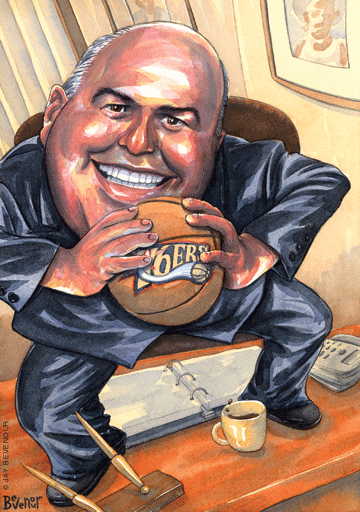
Class of ’76 | The Hall of Fame Room at the Wachovia Center was packed with icons of Philadelphia basketball early last month. Over in a corner were playground legend Sonny Hill and former La Salle University coach Speedy Morris. John Nash, general manager for three NBA teams over the years, held court in one section of the room, while former Penn and current Temple University coach Fran Dunphy was in another.
They were all there to welcome back one of their brethren: Ed Stefanski W’76, who had just been named president and general manager of the Philadelphia 76ers.
“This is a guy who was just too good for us to pass up,” said 76ers chairman Ed Snider. “The next year is going to be very important for the future of our team, and I just believe that he is the right guy for this organization at this time.”
Having spent the past nine years moving up the front-office ladder of the New Jersey Nets, becoming that team’s GM in 2004, Stefanski was taking on a challenge in Philadelphia. The Sixers were dead last in the Atlantic Division, with the worst attendance in the league. But for Stefanski, it wasn’t a difficult decision.
“It is easy to say you come home,” said Stefanski, “but the 76ers are very close to my heart. I am a Philly guy through and through. I die with every Philadelphia team.”
The road to the Wachovia Center has been a winding one for Stefanski. The basketball bug bit him early, first at Monsignor Bonner High School in West Philadelphia, then at Penn, where he was a sub who paid attention.
“By the time I was a senior, I had the best seat in the house,” he says. “I sat right next to [Coach] Chuck Daly at the Palestra for every game. I learned a lot sitting on the bench, and, with great luck, it has led me to a perfect place.”
Stefanski thought he might have the aptitude to be a good coach, but after graduating from Wharton in 1976, he went to work in the mortgage banking business.
“I always thought I would be a coach, but my Wharton friends said, ‘Go for the money,’” recalls Stefanski. “Funny thing is, the people at the mortgage company liked to hire ex-jocks, because they were competitive and knew discipline. For a good long time, it was the job for me. We did quite well.”
Stefanski didn’t completely abandon basketball, though. He was a color analyst for Big 5 and Atlantic 10 basketball telecasts, and he coached at his high-school alma mater, Monsignor Bonner, first for two years with the junior varsity, then for four years as head coach, winning the Philadelphia Catholic League Championship in 1983.
But after a while, something had to give. “We had four young children and the mortgage business was booming, so I really had to give up the coaching,” Stefanski says. “It killed me, but it was taking too much time and energy.”
Nine years ago, the company for which he was working was sold. An old friend from the basketball world—Nash, then the general manager for the Nets—asked him if he wanted to try his hand at scouting college players. Stefanski jumped at the opportunity, despite the fact that it represented a “very large” pay cut.
“I was 44, but I thought, if I didn’t do it now, when would it happen?” he explains. “It was the best move, obviously, I ever made. It isn’t even a job, almost, but a passion. Sometimes I can’t believe I am in the NBA.”
After Nash left the Nets, Stefanski found a mentor in Rod Thorn, the team’s president, who had been an outstanding NBA player before going into management. Thorn made him director of scouting and then, two years ago, general manager.
“I am very happy for Ed,” said Thorn. “I hate to lose him and he did a great job for us. There is no question that he knows all parts of the game and the business and is bound to do good things for the 76ers.”
With the 76ers, Stefanski will run the basketball operation, but also have a hand in marketing and other parts of the business.
“We needed someone to come in and lead us in a different direction,” said Snider. “Part of what we need is to connect with the city—whether it is with fans or with the general business community. Ed can do that with his local connections, his basketball acumen, and his knowledge of how to run a business.”
Stefanski’s favorite part of the business is something most fans would identify with: hanging with the players.
“With the Nets, I tried to see two or three players a day, just to talk with them and see how they were doing,” he says. “I think that is my strength. I especially root for the young players.”
Leading the team he has loved since childhood is a dream job for Stefanski, who is now closer to the players than he ever would have believed.
—Robert Strauss

